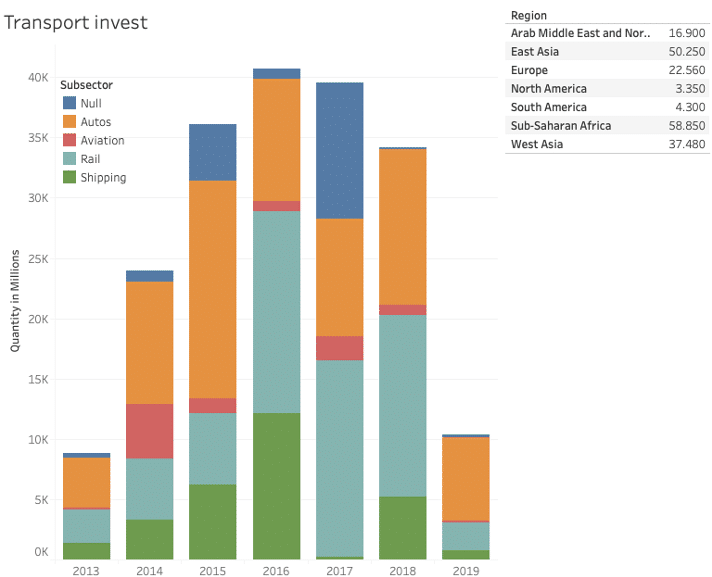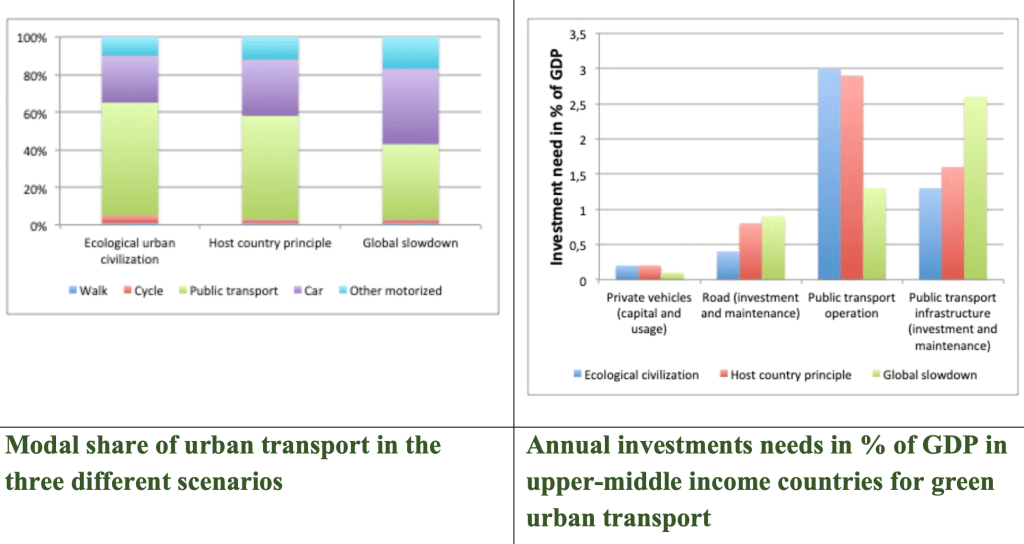For the Chinese version, click here.
Introduction
Greening urban transport is paramount to achieving global climate targets. With urban population increasing by 2.5 billion people, particularly in many countries of the Belt and Road Initiative (BRI), much hope is put on green mobility technologies and innovation. Their application depends on the availability of investments and smart policies. In this summary of a research project financed by the EC-Link project of the European Union, three urban transport scenarios for the year 2033 are presented. They are designed to help understand possible development paths, financing needs and climate impacts.
The full report will be published by the European Union in early 2020.
Urban transport developments in the Belt and Road Initiative
The BRI aims to increase economic activity by improving connectivity of economic areas through infrastructure investment. Since 2013, Chinese investors have financed about 194 billion USD on transport related projects in BRI countries (see Figure 13).[1]

Figure 1: Chinese transport investments in BRI countries (Data until June 2019). Source
As a consequence of these investments, cities along the BRI, both within and outside China are evolving and even new cities, such as Khorgos in Kazakhstan, are developing as new centers for trade. Within the cities, urban mobility will develop accordingly e.g. with higher economic activity, more disposable incomes, growing populations. Yet, with transport being the fastest growing contributor to green-house gas emissions (e.g. due to on-demand mobility, e-commerce delivery), even “best in class scenarios” seem insufficient to lower emissions sufficiently. Financing green urban mobility solutions in BRI cities will therefore be crucial to minimize future urban transport emissions.
Financing green innovation in urban transport
Rapid innovation in urban mobility has the potential to accelerate decarbonization of urban transport. Major drivers for mobility innovation include electric mobility, autonomous driving, shared mobility, digitalization and big data platforms as well as connected mobility. While the availability of these technologies relies on the provision of finance and policies, their sustainable application mostly depends on policy incentives. Examples include:
- Autonomous taxis could increase individual transport and thus vehicle-road-kilometers or be applied for autonomous busses with flexible routes.
- big data application could be used for improved route optimizing or increase unnecessary and energy-intensive data collection and storage.
- Electrification could lead to lower emissions from urban buses or to climate-relevant and environmentally dangerous waste of batteries.
Thus, with the right choices, mobility innovations can make BRI cities greener and more livable. Chinese cities, for example, have integrated policies and investments to accelerate the application of electric buses: by the end of 2018, 18% of China’s total bus fleet had been electrified and of the 425.000 electric buses in operation worldwide, China operated about 421.000.
In order to better understand policies that accelerate green or less green urban transport finance in BRI cities, three scenarios for the year 2033 – the 20th birthday of the BRI – were developed. The scenarios are not to be mistaken for predictions – they serve to show possible development paths, their risks and potentials for finance.
Scenario 1: Ecological Urban Civilization
China, BRI countries, and Europe as signatories to international treaties (e.g. Paris Accord) have, by 2033, achieved the following:
- environmental protection and international cooperation continue to strengthen, e.g. within the frameworks of the UN;
- policy emphasis has been put on investing in public urban transportation in BRI cities and the application of green urban mobility technologies (e.g. e-mobility, shared transportation, big data for transport optimization);
- Due to policy coordination between countries as well as an emphasis on capacity building for integrated planning of urban transport and urban landscapes, local authorities and investors could increase both yield on investments (e.g. public transport becoming more lucrative as fuel-subsidies have been phased out) and lower cost (e.g. as inefficiencies in planning and operation could be minimized);
- public transport has reached a modal shares in BRI cities of about 60%, while the private car only has 25%;
- CO2 emissions of about 350 million tons per year could be avoided in upper-middle income countries, particularly through electrification and behavioral policies.
- Achieving green urban transport goals requires investments of 170 billion USD per year, particularly in public transport operation (based on Julie Rozenberg and Marianne Fay (World Bank): Beyond the Gap: How Countries Can Afford the Infrastructure They Need While Protecting the Planet.)
Scenario 2: Host country principle
China, BRI countries, and Europe apply the principle that each BRI country and city should freely choose their own development path. By 2033, the host country principle has achieved the following:
- BRI countries and cities freely choose urban transport investment according to local knowledge and needs;
- Some BRI cities invested in sustainable mobility innovation (e.g. electric buses), others will emphasize basic mobility gains (e.g. addition of roads for individual mobility);
- Integrated planning between international investors was not seen as necessary, making economies of scale harder to achieve;
- Public transport has a modal share of 55%, cars of 30%;
- CO2 emissions of about 300 million tons could avoided through electrification and increased fuel efficiencies in upper-middle income BRI countries;
- In order to reach green urban transport goals, investments of 200 billion USD are needed per year
Scenario 3: Global slowdown
China, BRI countries, and Europe have seen an economic polarization and slow-down. By 2033, this will have the following consequences:
- investments in BRI cities from China and other countries have slowed down due to economic issues;
- international cooperation focused on strategic partners;
- selected BRI cities saw strong investments, some of which in new and green mobility technologies, some of which in other technologies;
- the modal share for cars increased together with those of other motorized vehicles (e.g. two-wheelers);
- CO2 emissions continued to increase;
- In order to achieve green transport for the future, investments needs have further increased, while the available investment amount is uncertain.
Summary
While BRI cities have the opportunity to profit from investments in green mobility technology, the development paths depend on investments based on smart policies and incentives. Based on different policies e.g. in urban public transport, the three scenarios show strong differences in required investments for greening urban transport.

By focusing investments and incentive
policies on applying green mobility technologies (e.g. e-mobility, public
transport), and building capacities for coordinated policy and planning,
investments can be smartly applied while the overall green investment
requirements for urban transport in BRI cities can be lowered by up to 15%.
[1] It is important to distinguish Chinese BRI investments between construction investments and businesses going abroad. Currently, most BRI transport-related investments are construction related investments (e.g. through government loans).
Dr. Christoph NEDOPIL WANG is the Founding Director of the Green Finance & Development Center and a Visiting Professor at the Fanhai International School of Finance (FISF) at Fudan University in Shanghai, China. He is also the Director of the Griffith Asia Institute and a Professor at Griffith University.
Christoph is a member of the Belt and Road Initiative Green Coalition (BRIGC) of the Chinese Ministry of Ecology and Environment. He has contributed to policies and provided research/consulting amongst others for the China Council for International Cooperation on Environment and Development (CCICED), the Ministry of Commerce, various private and multilateral finance institutions (e.g. ADB, IFC, as well as multilateral institutions (e.g. UNDP, UNESCAP) and international governments.
Christoph holds a master of engineering from the Technical University Berlin, a master of public administration from Harvard Kennedy School, as well as a PhD in Economics. He has extensive experience in finance, sustainability, innovation, and infrastructure, having worked for the International Finance Corporation (IFC) for almost 10 years and being a Director for the Sino-German Sustainable Transport Project with the German Cooperation Agency GIZ in Beijing.
He has authored books, articles and reports, including UNDP's SDG Finance Taxonomy, IFC's “Navigating through Crises” and “Corporate Governance - Handbook for Board Directors”, and multiple academic papers on capital flows, sustainability and international development.





Comments are closed.